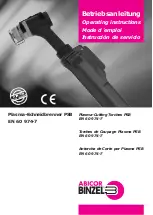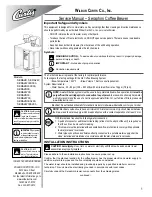
6 EN
PULLING SET CONTROLS DESCRIPTION
EN
5.0
PULLING SET CONTROLS DESCRIPTION
Picture 5.
1 - Welding system selector:
In position
press the torch button to start welding, and re-
lease to stop.
In position
press the torch button to deliver gas; on re-
lease, wire feed and current are activated; press again to stop wire
feed and current and release to shut off the gas supply.
In position
the welder operates in timed mode; press the
torch button to start the welding phase, which stops automatically
after the time interval as set on the timer potentiometer.
2 - Machine ON indicator lamp
3 - Machine overheated or anomaly warning light.
4 - Wire feed speed control -potentiometer
5 - Spot welding
time control potentiometer, from 0.3 to 10 sec-
onds. Operating only with selector (Ref. 1 - Picture 5 Page 6.) set
to position
6 - Wire feed
motor acceleration time control potentiometer.
7 - Control potentiometer
to regulate time during which welding
power is maintained after the relative shutdown signal. In practice,
at the end of welding, if this time is too short, the wire remains
stuck in the bath or protrudes too far from the torch contact tube;
otherwise, if the control time is too long, the wire remains stuck in
the torch contact tube, often causing damage to the latter.
8 - Advance wire button (without "current")
9 - Gas output test button
10 - Euro torch connector
6.0
BASIC INFORMATION REGARDING MIG
WELDING
MIG WELDING PRINCIPLES
MIG welding is autogenous, i.e. it permits welding of pieces made
of the same metal (mild steel, stainless steel, aluminium) by fu-
sion, while granting both physical and mechanical continuity. The
heat required for melting is generated by an electric arc that
strikes between the wire (electrode) and the piece to be welded.
A shield gas protects both the arc and the molten metal from the
atmosphere.
7.0
CONNECTION AND PREPARATION OF
EQUIPMENT FOR WELDING
Connect welding accessories carefully to avoid power loss
or leakage of dangerous gases.
Carefully follow the safety standards
N.B. DO NOT ADJUST SWITCHES DURING WELDING OPER-
ATIONS TO AVOID DAMAGE TO THE EQUIPMENT.
CHECK THAT GAS IS DELIVERED FROM THE NOZZLE AND
ADJUST FLOW BY MEANS OF THE PRESSURE REDUCER
VALVE.
CAUTION: SCREEN GAS FLOW WHEN OPERATING IN OUT-
DOOR OR VENTILATED SITES; WELDING OPERATIONS
MAY NOT BE PROTECTED DUE TO DISPERSION OF INERT
SHIELDING GASES.
7.1
WELDING
1.
Open the gas cylinder and regulate gas outlet flow as re-
quired. Fit the earth clamp on a part of the welding piece with-
out any paint, plastic or rust.
2.
Select the welding current by means of switches (Ref. 11 - Pic-
ture 1 Page 5., - Picture 2 Page 5.); bear in mind that the greater
the welding thickness, the more power is required. The first
switch setting is suitable for minimum thickness welding.Also
take into account that each setting features a specific wire drive
speed which can be selected by means of adjustment knob (Ref.
4 - Picture 1 Page 5., - Picture 5 Page 6.).
7.2
CARBON STEEL WELDING
For MIG welding, proceed as follows:
1.
Use a binary shielding gas (commonly a AR/CO2 mixture
with percentages ranging from 75-80% of Argon and from 20-
25% of CO2), or ternary mixtures such as AR/CO2/O2.
These gases provide welding heat and a uniform and com-
pact bead, although penetration is low. Use of carbon dioxide
(MAG) as a shielding gas achieves a thin and well-penetrat-
ed bead but ionisation of the gas may impair arc stability.
2.
Use a wire feed of the same quality of that of the steel for
welding. Always use good quality wire; welding with rusty
wires can cause welding defects.
1
5
6
7
8
2
3
4
9
10
For optimal welding, keep the
torch in the same direction as the
wire feed, as illustrated in figure.








































